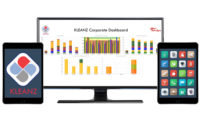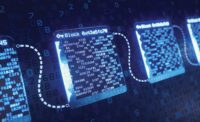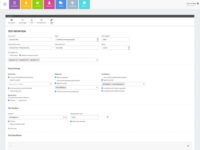Software that can provide facility-wide traceability—from the point where ingredients and packaging enter a facility, to the point of finished product distribution—is very important in the food industry. Food safety software can also help with internal food recall audits or tests, compliance with FSMA, and maintaining HACCP, GMPs, and SSOPs.
ERP software
Enterprise resource planning (ERP) software can help with providing traceability for ingredients, packaging and other aspects in the plant.
“An enterprise planning software is the database that manages the flow of internal business processes—all of the ingredient inventory currently in the facility, manages processing of purchase orders and shipping details connected to the finance system,” explains Dustin Caudell, vice president of sales, RFgen Software, El Dorado Hills, CA.
RFgen Software extends the functionality of the ERP system by adding barcoding and serialization capabilities, and automating procedures in the facility via mobile devices to increase productivity of the machines and inventory transfers.
“Raw material and finished goods tracking are foundational to any viable food safety system,” says Matt Brown, founder and CEO, Wherefour, Petaluma, CA. “ERP software captures intake data identifying materials received from specific vendors, when they arrived, who received them, where they were stored, expiration dates, and requires that lot codes be assigned to ingredients and packaging.”
Raw material intake data can be entered on something as simple as a spreadsheet, adds Brown, but ERP software automatically tracks those lots through real-world production where multiple ingredients from a variety of vendors are blended and processed into finished goods inventory. “ERP software also tracks lot codes sent to individual customers, including dates and times of shipment to specific locations, and the expiration dates of the finished product.”
Raw materials and ingredients are generally tracked by lot number—which is assigned by the supplier or internally at receipt, says Jude Holmes, client solution engineer, InfinityQS, Fairfax, VA. Similarly, products in an intermediate operation or process, like mixing, and finished products tend to have assigned lot numbers, as well. “Enterprise quality management systems have the ability to collect data on receipt of ingredients and to associate their lot numbers to intermediate and/or finished product lots to create a ‘lot genealogy.’ This provides end-to-end traceability of a product’s entire life cycle within a production site.”
Manufacturers can develop lot reports to show where a given ingredient was used, as well as what ingredients were used in a finished product lot, notes Holmes. In the event of a food safety issue, they can significantly simplify and speed up the otherwise time-consuming and expensive task of identifying and recalling affected lot numbers, protecting consumers and their business as a whole.
FSMA compliance
“Internal food recall audits or tests can be completed quickly using lot reports. Users can simply select either an ingredient or a finished good and get a complete breakdown of its genealogy from end to end,” says Holmes. “With an enterprise quality management system, compliance with FSMA, in terms of timely and accurate data collection, is built into the software. Manufacturers can also use the system to automate timed data collection and prompts to operators for scheduled quality checks needed for HACCP, GMP and SSOP requirements. Additionally, users can add links to any regulatory documents directly within the software for quick reference.”
RFgen Software enables food manufacturers to add barcoding, license plating and tracking of all components during the manufacturing process, and inputs that info to the ERP automatically, says Caudell. “Think of it as a serialization function for every step of the process, using barcoding to capture the specific inputs and outputs at every step, so that you can look backward or forward and see what you’ve used or what you’ve shipped and all the components along the way.”
It helps to tag raw materials with a lot number right away, says Todd Austin, senior application consultant, JustFood, Allentown, PA. “JustFood has embedded functionality to allow for the tracing of materials throughout the entire supply chain. These lot codes are tracked throughout the production process and are tagged to the finished item when sold. Within seconds, JustFood customers can track a raw material, where it was used, what item it was used in, and what customer purchased that item.”
Food recalls can be done within the system in a matter of seconds. JustFood also has a built-in Quality module which allows for QA testing throughout the lifecycle of an item. Embedded workflow within the Quality module acts as the framework for SSOPs as it identifies the steps required in QA: who is responsible for them, where they should be routed, and who needs to approve them. The JustFood system will then issue an alert on an overdue, passed or failed audit.
Nexcor Technologies, Inc., Atlanta, offers sanitation and maintenance systems that integrate either directly with equipment or to SCADA systems to carry out SOPs for product changeovers, and more importantly, allergen changeovers, says Robert Burgh, president. “Through comprehensive production monitoring, KLEANZ and CAMS-PM can provide alerts and enforce specified QA standards for our clients. The fundamental design of the systems focuses on areas in the facility by risk, ultimately helping clients prioritize the execution of their HACCP and HARPC. The cost savings of having an auto-documenting system brings incredibly quick ROI to the synergy of the facility.”
Food safety training
“There are typically no native food safety training aspects built into an enterprise quality management system,” says Lin. “However, the software could be configured to test a user against a specific set of questions to verify that they understand the procedures, regulatory requirements and food safety principles.”
JustFood has the ability to store training materials, such as manuals and documents, says Austin. “It also has the ability to store video recordings of procedures for employees to view. The UE is similar to YouTube—it allows users to consume training material like they are already used to in today’s digital environment.”
KLEANZ’s Resource Planning module tracks the training status of each employee, to ensure that work is not assigned to staff that does not have the appropriate training, says Burgh. KLEANZ can also report training gaps and alert management when further training is necessary.
In companies with a true food safety culture, modern ERP software reinforces and concretizes that culture in a system followed by everyone, says Brown. “It is much easier to teach new employees standardized processes and procedures that everyone uses. When new employees have questions, they get consistent, and correct, direction. ERP software bakes food safety into the system, so following good food safety practices becomes a way of thinking and acting for new employees from day one. Creating architecture that walks users through the process step-by-step makes it easier for new employees to learn the system quickly, and eliminates excessive complexity that can lead even seasoned employees to make mistakes.”







